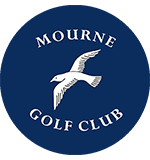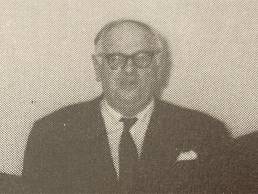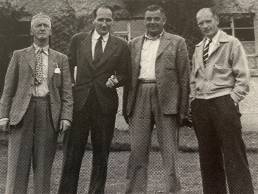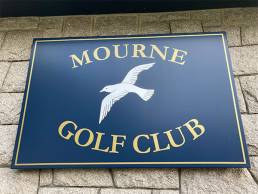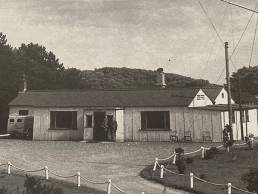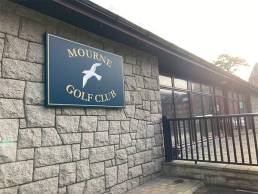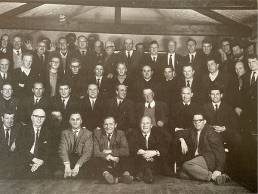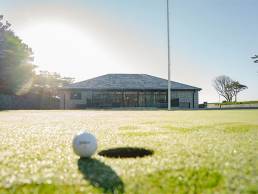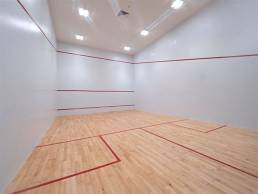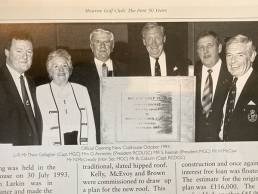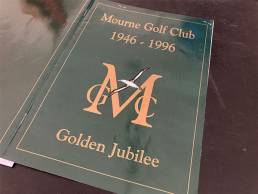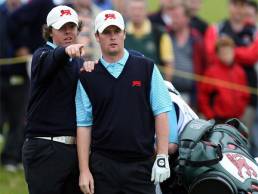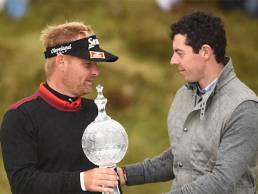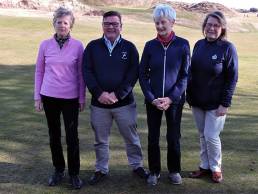
MOURNE GOLF CLUB
History
Dig a little deeper to find out more about Mourne Golf Club's history
History of Mourne Golf Club
The arrival of Mourne Golf Club on the Irish Golfing scene is recorded in the Golfing Union of Ireland centenary book with ‘Mourne Golf Club was founded in 1946 and affiliated to Golfing Union of Ireland in 1946′. Since then Mourne Golf Club has become part of the golfing campus at Newcastle alongside the renowned Royal County Down Golf Club and Royal County Down Ladies’ Golf Club.
Click on the headers below to read more…
TOWN MEMBERS SWEEP GOLF SOCIETY
Copy of First Annual General Meeting Minutes (14th October 1943)
The First Annual General Meeting of the Town Members Sweep was held in the Castle Cafe on Thursday 14 October at 8pm 1943. Thirty five members were present and the guests included Capt. Burrell, Secretary Royal County Down GC and Mr W Irvine, Steward, RCDGC.
Mr PJ Mc Evoy presided and in his opening remarks thanked the guests for gracing the function with their presence. With regard to the Sweep he said that the Committee had carried out the duties that fell upon them to the best of their ability. It was only natural that some mistakes had been made but the Committee had done all in their power to rectify them. The Prize List showed that the prizes had been fairly well distributed among members, and this, he thought was a tribute to the Committee in Handicapping. He stressed the fact that the members on the course had been exemplary and hoped that it would continue.
Capt. Burrell returning the thanks, also referred to the etiquette on the course. A few years ago there were only 30 members eligible for Town Membership. Now there are 60. He thought the chief reason for this was the conduct of the then serving town members. He concluded by expressing the opinion that the way in which the Sweep was carried out on was good for the game.
At the general meeting which followed, the retiring members of the Committee were re-elected. It was agreed that the Committee should be enlarged to five, and A. Corry and J. Whightman were chosen for the two places.
Further suggestions for improving the running of the Sweep were put forward and agreed upon and the meeting concluded with a musical programme.
Signed; P.J. Mc Evoy
SPECIAL GENERAL MEETING OF TOWN MEMBERS SWEEP
A Special Meeting of the Town Members Sweep was held in the Womens Institute Hall on on Tuesday 5th June 1945. Thirty eight members were present and Mr. P J Mc Evoy presided.
It was proposed by J.E. Marshall and seconded by P. Quinn that the club shoud be formed. This was passed unanimously . The election of office bearers then followed and unanimous approval was given to the proposal by J.E. Marshall seconded by J. Mc Lachlan that Mr P.J Mc Evoy be elected Captain. Mr McEvoy returning thanks, said that the goal towards which he and his former Committee had striven now seemed in sight and that the Captain would do his utmost to prove worthy of the honour conferred on him. He referred to the great debt of gratitude they all owed to J. McLachlan, without whose help they could have accomplished little.
For the position of Hon. Secretary three names were put forward. P Quinn proposed by D. J. Rafferty, seconded by J. McLaghlan, J E Marshall, proposed by G. Trainor, seconded by P.Quinn, S Laird, proposed by A Corry, seconded by T. Russell. On P Quinn and S. Laird withdrawing their names JE Marshall was elected.
For the position of Treasurer two names were put forward, P. Quinn proposed by A. Corry, seconded by S. Laird and R.W. Anderson, proposed by J.Trainor and seconded by W. Wheeler. on a vote being taken R.W. Anderson was elected.
On the proposal of B. Clarke, seconded by A. Gallery that ten names be nominated from which to elect seven Councillors, the following received nominations; A. Corry, P.Quinn, J. Trainor, W. Wheeler, JJ Toner, DJ Rafferty, PMcGrath. The Council were instructed to draw up a set of rules for submission to the members at a Special General Meeting to be held on Thursday 14th June 1945 in the Women’s Institute Hall. A discussion followed as to the name that the club should take and it was decided that they should submit two names, Newcastle GC and Mourne GC to the Royal Co. Down representative at the forthcoming meeting expressing preference for the former name.
P.J. McEvoy
COUNCIL MEETING HELD IN MR PJ McEVOY’S OFFICE 21 JANUARY 1947
A meeting of the Council was held in Mr. PJ Mc Evoy’s office on Thursday 21 June 1947. The Captain presided and the following Councillors were present; Messrs Toner, Mc manus, Rafferty, Wheeler,Trainor, Mc Grath, Anderson and Marshall. The minutes were read and adopted.The Council then went into the question of the building requirements for the clubhouse, and suggestions and arrangements were made to put the building in a habitable condition. Arising out of this it was proposed by Mr Anderson and seconded by Mr Trainor that the Annual General Meeting of the club be postponed until the 27th February 1947, when the meeting would be held in the Clubhouse. In connection with the building the following points were decided upon.
- that the bar and store should be in the brick structure.
- that lavatories and wash hand basins should be moved to locker room.
- that a porch be constructed at the main front entrance.
Mr.J. Trainor was instructed to see Mr.Regan regarding blocks, sand and cement.
Mr. P.J. Mc Evoy was instructed to see Mr. Wadsworth regarding doors and Mr McCammon regarding windows and also to Mr H. King regarding matting, card tables and locker. Mr Wheeler to prepare drawing for porch.
Mr Trainor to make enquiries regarding chairs, plaster sheeting. Mr DJ Rafferty to see to wiring etc. it was decided to ask club members to lend money to finance the club loans to be repaid after three years by ballot. £1000 was the sum required.
P.J. Mc Evoy
25 March 1947.
Notes on the above minutes
The sample minutes taken from the records of the Town Members Sweep Golf Society that were recently donated to Mourne Golf Club certainly give us an insight as to the very first beginning of Mourne.
The minutes indicate that the “Sweep” was well known to Royal County Down Golf Club and had its blessing and agreement for its members to play on the Championship Links. The fact that the Secretary of Royal County Down, Capt. Burrell and the Steward attended the meeting is notable in itself.
As we read through the early minutes they show that by June 1945 members of the “Sweep” were seriously discussing the formation of a “Club”. The general consent was that these views should be taken forward for discussion with Royal County Down Golf Club. It is interesting that the preferred name of the new club was Newcastle and not Mourne.
The minutes of the January 1947 Council meeting shows that the newly formed club was not ready for business or members to use. It records in some detail how Council went about the business to renovate and refurbish the premises and have it ready for the forthcoming Annual General Meeting. These early day minutes show the determination and enthusiasm of the Council at that time to manage refurbish the new Mourne club. We owe so much to these early pioneers of Mourne.
(Theo Gallagher)
The arrival of Mourne Golf Club on the Irish Golfing scene is recorded in the golfing Union of Ireland centenary book with half a line – “1946 Mourne, A 1946.” Expanded into a sentence, this reads “Mourne Golf Club was founded in 1946 and affiliated to Golfing Union of Ireland in 1946.”
The centenary book of Royal County Down Golf Club is a bit more generous and gives the event the following two paragraphs:
“There was, however, one very significant move which took place in the closing years of the war. Gerald Annesley, grandson of the first president and now landlord, took a positive step forward on behalf of the townspeople of Newcastle. He wrote to the Council of Royal County Down reminding them that the town had become a substantial seaside resort and was no longer the fishing village of 1889. He proposed the establishment of a club for the residents of the Newcastle area, under the auspices of Royal County Down, and with separate premises. Council’s characteristic reaction was to appoint a sub-committee; this did not betoken reluctance but they wished to be sure of the implications for all parties.
“For example, on handicapping and other issues, the Golfing Union of Ireland had to be consulted. Two years later details were finalised, but in the meantime Mourne Golf Club, as it had been named was seeking accommodation and the huts which had been used by the Civil Defence Authorities between the Clubhouse and Slieve Donard Hotel were found suitable. A lease was arranged as soon as the government sold them. Hours were set during which the members should play and financial relations, membership control and overview of their rules were agreed. Mourne would fix its own subscriptions and handicaps and be affiliated to the Golfing Union of Ireland. Thus was established what quickly became a thriving club and a major contributor to the golfing scene in Ulster. Mourne made a generous and complimentary gesture to Royal County Down by electing Gerald Annesley and D Wilson Smyth Honorary Life Members.”
Hidden behind both entries however, is the story of the founding of Mourne Golf Club – a story which Mourne members, at least, should know.
The beginning of the parent club, Royal County Down, the design of the course by Old Tom Morris and the evolution of golf in Newcastle are well documented and well known by golfing historians throughout Ireland since the publication of Royal County Down’s centenary book in 1989.
Perusal of that well-produced volume will show even the most casual reader that the new Co. Down club (it didn’t get the royal patronage until 1908) was almost exclusively associated with Belfast. The local interest was mainly supplied by the landlord, Lord Annesley. The Annesley name became associated with both clubs, and is still held in high regard in Mourne. As time progressed more locals became involved in the game of golf – some as caddies, some as employees of the Belfast and Co. Down Railway (a special relationship existed between the railway, including the railway hotel, and the golf club to their mutual benefit). Some of these young locals exhibited such a prowess for the game that they became assistants to the local professional and later became professionals themselves, spreading the gospel of golf throughout many parts of Ireland:
James Cromwell (Knock), Irish Professional champion 1921. Joe Edgar (Portadown, Kilkeel, Helen’s Bay, Clandeboye). Danny Murray (Lurgan, Castletroy, Ballybunion). William McCavera (Lahinch). John McCourt (Warrenpoint, Limerick, Rosses Point). Tommy McGrath (Greenisland, Limerick, Enniskillen, Birr, Adare), Pat Sawey (Royal Belfast). Hugh Sawey (The Curragh). Louis Skillen (Donaghadee).The Golfing Wallaces: Leo (Ormeau, Bundoran) Irish Professional Champion 1928. Willie (Carnalea).Bobby (Galway). Paddy (Adare, Dungannon). Jack Williams (Downpatrick, Portadown, Ballymena).
Other locals, apart from caddies and BCDR employees, began to take an interest in the game and the category Town Member was created by the Council of Royal County Down.
The name Town Members persisted until the 1980s when it was replaced by the term Town Associates. Town members were drawn from an area within five miles of Newcastle. They paid a reduced fee for restricted playing rights but had no clubhouse facilities or official handicaps. They left their clubs in the local professional’s shop and the then professional, one Jack Mclachlan, a canny Scot with an eye for business, organised a weekly sweep for these Town Members. His unofficial handicapping system bore a distinct resemblance to the Turkey handicaps which obtain in many clubs in the “close” season. The price of entry to the sweep was one shilling. The famous. ‘Shilling Sweep’ was born and survived into the early years of Mourne Golf Club.
The numbers competing in the Shilling Sweep increased. Town Membership was easily obtained. Bill Cleland, for example, applied verbally for membership through the caddie master on a Friday afternoon and on the following Wednesday was informed that his application had been successful.
In tandem with an increase in membership of the Shilling Sweep came an increase in golfing skill. Many of the golfers under Jack McLachlan’s handicapping system became “plus men”, notably the Toner brothers, Jimmy and John Joe, Alfie Corry and Brian McManus. The last name in particular was a major factor in the train of events which led to the formation of Mourne Golf Club. Brian was the son of Jack McManus, owner of Ye Olde Bar. Following his education in St Malachy’s, Belfast, Brian had the time and the inclination to enter many open competitions which he did with distinction collecting en route the scalps of such notable golfers as Joe Carr and John Burke.
He had however one major problem – he did not belong to a duly affiliated club. Newspaper cuttings from the time show that Brian entered these competitions under the auspices of Warrenpoint GC and Downpatrick GC.
In the opinion of many it was this fact that prompted Gerald Annesley, grandson of the first President of Royal County Down, to write to the Council of Royal County Down during the closing stages of World War II, proposing the formation of a local club for the residents of the Newcastle area.
The proposal was accepted and a meeting of local golfers was held in the lifeboat house, later the Women’s Institute and now the Elim Pentecostal church on the Downs Road.
The name Mourne was proposed by Mr Gerald O’Donoghue and accepted as the name of the new club.
The first captain was Mr P J McEvoy, a local bookmaker, who, although Irish by parentage, was raised in Glasgow and had a distinct Glaswegian accent. He was a keen sportsman with a great interest in soccer and was for a while on the books of Glasgow Celtic.
Luckily for Mourne he had two other qualifications which led him to the captaincy. He had a great interest in golf and had sufficient money to grubstake the infant club in its shaky initial stages.
First and foremost, the club needed premises. Wartime huts situated between Royal County Down and Slieve Donard Hotel were deemed suitable. Unfortunately on demobilisation they were purchased by Mr Ivor Taggart, a local builder who was then developing the Tullybrannigan area. It was at this time that P J McEvoy’s third great attribute came into play – he was an able negotiator. A meeting was arranged with Ivor Taggart m a licensed premises (it is presumed) and the combination of good Scotch whisky and Scottish blarney won the day – the huts were acquired from Ivor Taggart for the price he paid for them £100, which just happened to be the amount PJ McEvoy had in his hip pocket.
Pat McEvoy efforts on behalf of Mourne were rewarded by making him Captain for the first four years of the existence of Mourne. When he indicated he wished the captaincy of Mourne to go to someone else a grateful AGM created for him the office of President, a post he held until his death in 1965.
An original painting of P J McEvoy was commissioned from Bond Walker and hangs in a place of honour in the Clubhouse.
Lest it be thought that the founding of Mourne Golf Club was a one-man show let it be known that he was aided, abetted and constantly encouraged by many others but chiefly by Peter McGrath, manager of Quinn’s of the Milestone, and by Fred Mr PJ Mc Evoy, President MGC, Mr A. Anderson, Treasurer MGC, Joe Edgar; Jack Mclachlan
Wadsworth Sr, a local draper, both of whom were very friendly, in a convivial sort of way, with Gerald Annesley, hence the latter’s letter to the Council of R. C.D. It was a tribute to the above named triumvirate that they were appointed first trustees of the new club.
A strong supporter of the Annesley proposal within Royal County Down was D Wilson Smyth. He was a powerful ally to have. He was Captain in 1921, 1922 and 1931. He was Honorary Secretary from 1936 to 1953 and, above all else, he was an excellent golfer. In the year of his first captaincy, 1921, he won the Irish Close Championship over the local course. His family inherited his golfing talent especially his daughter Moira. One day while she was practising on the Number 2 course she met P J McEvoy who was so impressed with her play that he invited her to join the Shilling Sweep where she would meet golfers worthy of her talent. She was delighted but, more importantly, so was her father and it is no coincidence that the two premier cup competitions in Mourne Golf Club are the Wilson Smyth Scratch Cup and the Annesley Cup. In return both G F Annesley and D Wilson Smyth were elected honorary Life Members of Mourne.
So began Mourne Golf Club, and it was not without an amount of nostalgia that the remaining few Shilling Sweepers’ saw their original home fall to progress leaving them with nothing but their memories.
(Excerpt from the Mourne Golf Club Golden Jubilee Publication: Stephen Keenan & Theo Gallagher)
Having acquired the premises, work began immediately to transform them into a clubhouse. Unwanted buildings had to be demolished and disposed of. As in the Bible, hills were laid low and valleys filled up.
The hills, in this instance were the numerous unwanted brick buildings stores, cook house etc. – most of which were knocked down and deposited into a deep valley abutting the present laneway from the Royal County Down car park to the back gate of the Slieve Donard Hotel. This area was later converted into a putting green. All the work involved in demolition, conversion and construction was carried out on a voluntary basis. The original Shilling Sweepers’ were joined by some newly elected members. Materials required were bought and paid for by means of an interest free loan from the members – a tactic which stood Mourne in good stead not only in the beginning but at every development over the years. It is usually invidious to mention names when so many people were involved in the work. However few should feel aggrieved if the names of Jimmy McCormick, Sean Dornan, Paddy McCrickard and Paddy Boden were recorded.
Jimmy was a local building contractor and a member of the Shilling Sweep. He automatically became architect and clerk of works of the reconstruction. He later became a member of Council and was elected Captain in 1955.
In 1963 he singlehandedly adapted the old lockers to fit the new locker room. The McCormick putter, played for at every Annual At-Home is a tribute to his memory and an appreciation of his work for Mourne.
Sean Dornan, Paddy McCrickard and Paddy Boden were not members of Mourne Golf Club when they were press-ganged into offering their expertise in the conversion of the Civil Defence huts into a Clubhouse. Paddy Boden did the internal plastering and Paddy McCrickard built the red brick fireplace which became the focal point of the new lounge and which is still remembered with nostalgia by the older members. Sean Dornan, also a building contractor, later joined the Club and was elected Captain in 1959 – the only year in which Mourne won an All -Ireland Trophy – The Junior Cup under the captaincy of Hugh King.
The floor of the present Main Lounge made of Japanese oak, The Original Clubhouse acquired, somehow, in the post war period when hardwood timber was well nigh unavailable, is the only part of the original Clubhouse still remaining. It is a tribute to the skill of the volunteer workers and is a treasured link with the past.
The name of Gerald F. Annesley once again crops up in the story of Mourne Golf Club – this time as a benefactor. He presented the Club with its billiard table, its coal-fired heating system, various articles of furniture and several trophies of shooting expeditions in Africa. Finally, in Peter McGrath’s Captaincy he presented the turves for the putting green which he officially opened in the following year in the Captaincy of Jack Hodgkins.
And so, Mourne had a Clubhouse, noted throughout the land for its hospitable ambience. With the additions and renovations mentioned in the next chapter, it served us faithfully and well for almost half a century and many mourned its demise.
(Excerpt from the Mourne Golf Club Golden Jubilee Publication: Stephen Keenan & Theo Gallagher)
The original lease of Mourne Golf Club stated that the club could be wound up by either party (RCDGC or MGC) unilaterally during the first 15 years of its existence. This factor of insecurity and the additional factor of financial constraint meant that no improvement was made to Mourne Golf Club or its environs save that of tarmacing the forecourt during the Captaincy of JE Marshall in 1960.
In late 1961, however, on completion of the aforementioned 15 years the then President, P J McEvoy, raised the question of replacing the two Nissen huts, which formed the Billiard Room and Locker Room with more substantial structures. Both huts were stone flagged, draughty and rat infested – but the club was deeply in debt.
Things began to look up however. PJ Rodgers took over as treasurer from Stanley S McCammon (Snr.) in June 1961. Stanley had laid a strong hand on the club’s finances but found that this duty, combined with running a successful business, too demanding and he resigned, mid-term, in favour of Pat Rodgers.
Pat’s meticulous book keeping and strong financial control continued and enhanced the firm foundations laid by his predecessor. Bar profits jumped from 19 per cent in 1959 to almost 40 per cent and continued at this from then onwards. Pat remained Hon. Treasurer and subsequently Secretary to the Club from 1961 until 1993.
Encouraged by this development, P J McEvoy convinced a reluctant Annual General Meeting that we could afford the cost of the new building.
Belfast architect, Gerry Marshall, was engaged to draw the plans which were then put out to tender. The firm of Dornan Bros. submitted a price of £3,000 which was the lowest by far. Work began in 1962 in the Captaincy of George Crilly and the building was officially opened by GF Annesley on 6 February 1964 in the Captaincy of Francis Dornan – one of the contractors.
As mentioned before, the lockers from the old locker room were adjusted by Jimmy McCormick and installed in the new building. The addition of a wood block floor in the Billiard Room, the purchase of a new billiard table and the installation of showers and other amenities not covered by the contract added another £2,000 to the contract price.
Another interest free loan was floated, a building levy was imposed and these together with fund raising activities, especially Bingo, cleared the debt in three years as the President had forecast at the Annual General Meeting.
Good husbandry during the remainder of the sixties enabled the Club to take another step forward towards the end of the decade. This time it happened almost by accident. As the photograph on page 13 shows, the lounge consisted of two corrugated huts similar in shape and style to the huts in and around the Army Camp at Ballykinlar. In the immediate post-war years many of these huts were plastered and converted to substantial looking dwellings.
Coming as he did from Ballykinlar, the then Hon. Secretary, Stephen Keenan, proposed in Council that a similar exercise be undertaken to enhance the look of the Clubhouse.
Sean Dornan, however, advised Council that, unlike the huts at Ballykinlar which were made of corrugated iron, ours were made of corrugated asbestos. It would not be feasible to nail the wire cladding, necessary to hold the plaster, to asbestos. The only way, Sean told Council, that the exterior of the Clubhouse could be enhanced was to build a masking wall outside the asbestos.
It was at this stage in the debate that Brownlow McClean, with an eye to the future, proposed that if a wall was to be built, it should be built some 12 feet out from the existing wall thereby giving the Club an extra lounge plus a new Secretary’s Office/Committee Room. The existing Committee Room which doubled as a TV room was later converted into a kitchen situated where the present kitchen now stands. The new Secretary’s Office is now the Members’ Bar.
Council agreed and Gerry Marshall was again engaged. His plan was passed by the Annual General Meeting in 1968. The estimated cost based on the square footage was £7,000.
This time the work was carried out by direct labour by Jim Doran assisted by Ricky Coyne. With furnishing and carpeting added the completed structure cost around £12,000 and was officially opened by the Captain, GF O’Boyle, in 1971.
This extension became known as the Sun Lounge and doubled as a bowling alley and dining room for 20 years.
During the next decade inflation was rampant so that the tender for the next extension was a phenomenal £100,000 plus carpeting and furnishing. This time the plan was to build a new Locker Room and Squash Court and to convert the current Locker Room into a store room and Council Chamber. The Secretary’s Office remained in its old position. feasible by grant aid from the Department of Education. This grant, £50,000 was acquired through good offices of Paddy O’Donoghue, a local Councillor. As a member of Mourne he was naturally interested in the advancement of the Club and as a Councillor he was interested in the provision of another amenity in the town.
Squash was the craze and the most popular fitness activity at that time. Since there was no such facility in Newcastle the Department Officials authorised the grant providing that our exclusive laws were relaxed.
The co-operation of Royal County Down was sought and acquired. They agreed to alter and extend to term of the lease to accommodate the requirements of the Department of Education.
Gerry Marshall was again the architect and the tender of McCall of Clough was successful. The new extension was opened in 1981 by the Captain, D S Hanna. Unfortunately a sudden death in the Squash Court had a detrimental effect on the game’s popularity in Mourne and with the permission of the Department of Education it was converted into a Juvenile Games Room in 1987.
The lockers for the new Locker Room were built and installed by Rodgers Bros of Castlewellan.
In 1985, the Captain of that year, William Holmes, convinced Council that it would be a good idea to remove the Secretary’s Office to the Council Chamber (which was divided for the purpose) and to convert the old Secretary’s Office into a Members Bar/TV Room.
Council agreed and the work was carried out by Rodgers anc Graham of Annalong.
Carpeting, built in furniture and chairs raised the cost to some £8,000. However it was well conceived project and became the most popular room in the club for the next eight years. It was the first direct development in the bar area – the only revenue creating area i1 the Club.
This concept of developing the bar area was the basis of the plan submitted by the successful firm for the renovation of the entire Clubhouse for the Golden Jubilee in 1996.
The approach of the Golden Jubilee had engaged the mind of Council for a number of years but it was not until 1992 in the captaincy of Norman McCready that he and the Hon. Secretary, Theo Gallagher, decided that the time had come to put some flesh on the skeletal ideas of the previous few years.
Their proposal, which Council accepted, was to contact a number of contractors who specialised in the type of work envisaged by Council, to present each of them with a plan of the existing Clubhouse, to give each a broad, idea of what Council had in mind and to ask each to prepare a plan and estimate for the development of the Club.
In all, five contractors submitted proposals and in 1993 in the Captaincy of John Dornan, the plan of architect Eamon Larkin of the firm of Kelly, McEvoy and Brown was accepted by Council.
The plan was exhibited in the Clubhouse for some weeks and an Extraordinary General
Meeting was held in the Clubhouse on 30 July 1993. Eamon Larkin was in attendance and made the presentation on behalf of Kelly, McEvoy and Brown.
The meeting accepted the idea enthusiastically with one proviso. Led by Tom Mullan the members were of the opinion that the corrugated, plastic covered metal roof would make the Clubhouse look too much like an industrial complex and would be subject to rapid deterioration due to its close proximity to the beach and the corrosive sea. air. They advocated a traditional, slated hipped roof.
Kelly, McEvoy and Brown were commissioned to draw up a plan for the new roof. This was presented to members at a second Extraordinary General Meeting on 11 October 1993. The vote in favour of the plan for the slated roof was almost unanimous.
Work began on 26 October 1993 and was finished on 24 May 1994. The new Clubhouse was officially opened by the Captain, Theo Gallagher, on 1 October 1994.
As with previous developments members were levied to help pay for the construction and once again an interest free loan was floated. The estimate for the original plan was £116,000. The roof added another £45,000, while furnishing carpeting and fixtures boosted the final figure to £240,000. A levy consisted of £30.00 per annum for four years from 1992.
A further levy of £40.00 per annum for two years was passed by another Extraordinary General Meeting in 1995 .
Mourne Golf Club had left the corrugated asbestos era and now has a splendid, functional Clubhouse adequate for the demands of the new millennium.
(Excerpt from the Mourne Golf Club Golden Jubilee Publication: Stephen Keenan & Theo Gallagher)
How good were the Golfing Greats of Mourne in the early years? Memories can some times play tricks and the past is sometimes viewed by members through rose tinted glasses. It is better to have an independent view.
In 1947, the East of Ireland championship was sandwiched between the West of Ireland and the trials for places on the International Team. It was anticipated that the Baltray event would suffer as a consequence. An article in the Irish Press, however, had the following paragraph.
“The support accorded by Ulster Clubs and especially by Mourne and Warrenpoint Clubs has been remarkably good and though their main strength is in point of numbers, they include a number of very useful players, notably J Toner, Brian McManus and Willie Hulme all of whom are just about international class”.
Praise indeed. Unfortunately, only W Hulme became an international and that was only achieved in the autumn of his career. Nevertheless, Mourne’s representatives were of international class and proved it time and again in Irish golf.
The establishment of the Ulster Golfers’ Alliance in the 1940’s to improve professional and amateur golf in Ulster certainly worked as far as Mourne was concerned and the names of Toner and McManus appear very often in the prize lists. Playing alongside professionals such as Fred Daly certainly had a beneficial effect on the competitive qualities of the above named players.
BRIAN McMANUS
One of the few Mourne men who came to be recognised by his initials only, BC had a most impressive record. In 1944 BC McManus (Downpatrick) and PG Stevenson (Royal Portrush)were beaten in the final of the Hermitage Pro-Am Match play final by P O’Connor and Brendan Seannel of Woodbrook.
In 1946, BC reached the 4th round of the Irish Open at Portrush. In 1948, he beat John Burke 2 and 1 in the first round of the Irish Amateur Open at Newcastle. Burke at the time was the holder of the title and won the Irish Amateur Close Championship eight times. In 1949, Brian was beaten by Webster of Portmarnock at the 20th in the semi final of the West of Ireland at Rosses Point.
Also in 1949, Brian was the leading amateur after the 1st Round of the Irish Open in Belvoir Park with a score of one under par.
The Press had the following to say of him “One of the best performances of the day was that of Brian McManus, the young Newcastle amateur who is an auctioneer. He beat bogey (par) by one stroke”. His card being:
Out 4 4 5 3 5 5 4 3 5 -38
In 5 3 4 4 4 5 3 4 4 -36
The lead was shared by Flory Van Donck (Belgium) and Harry Bradshaw (Kilcoroney) both on 70. Of the field of 104 only 16 broke par (75) on that day. Bradshaw was the eventual winner with A D Locke, the British Open Champion, runner-up. BC and Bradshaw became great friends.
In 1950 Brian reached the final of the Irish Native Golf Championships at Baltray, Co. Louth. En route to the final he knocked out J B Carr, six times winner of the Irish Close, four times winner of the Irish Open, and later to become the first Irishman to be Captain of the R&A. Brian was beaten in the final by B Herlihy of Portmarnock.
In later life he interested himself in Mourne’s Juveniles and was mentor to Eamon Crawford when the latter won the Ulster Boys’ Championship at Donaghadee in 1977, beating Tom Corridan, later an Irish International, at the 18th.
Alfie Corry
A native of Belfast, Alfie joined the RUC in 1926 and after a short period in the depot in Newtownards he was posted to Newcastle where he completed his service. A sensible and popular officer, Alfie, without being derelict in his duty, was more inclined to show the yellow card rather than the red one. He commanded the respect of the entire community not least among the members of Mourne, where he led by example. His first handicap with the Shilling Sweepers was 18 – his lowest was plus 1. When he retired in 1963 he still had a handicap of 2.
Alfie’s duties prevented him from entering as many amateur events as he would have liked unless they were played in Newcastle. At such times he distinguished
himself especially in 1955 when he reached the quarter finals of the Irish Open Championship, being beaten at the 18th by the eventual winner, J F Fitzgibbon of Cork who beat J W Hulme of Warrenpoint in the final.
In the British Police Championship his record was second to none. He was selected as a member of the RUC team every year from 1930 to 1961 and won the Individual Championship as follows:
1939 at Southport and Ainsdale 194 7 at Royal Porthcawl
1948 at City of Glasgow
1949 at Royal Lytham and St Annes (Where he shared 1st Place in a triple tie).
Moira Smyth, daughter of D Wilson Smyth partnered Alfie in the RUC Mixed Foursomes which they won four times.
In domestic golf, he won the Scratch Cup on many occasions, and captained the Senior Cup team which won the Ulster Section in 1947. The All-Ireland finals that year were held in Lahinch in Munster. As none of the Mourne team had ever played the course, they travelled down to Lahinch three days early to practise. Unfortunately, on the first day of practice they got to the 6th hole when the heavens opened and washed out the practice on that day and on each of the following practice days. Not surprisingly, they were beaten comprehensively by the Munster Champions, Muskerry.
The Mourne team was J J Toner, BC McManus, A Corry (Captain) James Toner and J E Marshall.
In 1950, Mourne won the Ulster Section of the Barton Shield. However neither Alfie nor BC were available for the All-Ireland Finals at Baltray. In their place went John Doran and Dan Rafferty.
The pairings were JJ Toner / John Doran and James Toner ID Rafferty.
Unexpectedly they beat a strong Galway team by one of the biggest margins ever recorded in the Barton Shield. However, in the final they had to give best to a Sutton team which was composed of JB Carr / JP Carroll and M Fitzpatrick/ RH Mclnnally.
The Toner Brothers
Both John Joe and Jimmy Toner were of international class and given the opportunity would have made it into the big time. They were, however very different. John Joe was a “natural”. To the casual observer it seemed as if the taking up of the stance, the address, the take away and the delivery of the stroke was one continuous, flowing action with little or no delay. His progress round the course was so quick that he earned himself a line in one of Bunter’s (J E Marshall) famous parodies.
“If John Joe took more than two hours flat then I’d be surprised at that.” – A lesson perhaps to the younger generation!
Jimmy, on the other hand had the same natural talent but was more analytical and methodical with the potential of becoming a first class professional. He practised until dark and even after dark. On one occasion, related by Bill Cleland, it was so dark he couldn’t see the flight of the ball, so he knelt down and examined his divot and forecast precisely where the shot would land.
At other times, also late in the evening he would surreptitiously invade the premises of the local rugby club. From outside the playing area he would draw eight iron shots between the goalposts. That done he would then transfer to the opposite side of the pitch and fade the shots through the same posts – dedication indeed and a further lesson to the younger generation.
At an early age Jimmy moved to the London area where his golfing career blossomed. In addition to winning the Scratch Cup in Mourne in 1950 he was Club Champion eight other times at four different clubs.
Richmond Golf Club 1955 & 1956
Finchley Golf Club 1957 &1958
Whitewebbs Golf Club 1963 & 1965
Crews Hill Golf Club 1966 & 1967
He led the Middlesex team in the Inter County Championship of South East England. The team were runners up in the Championship and Jimmy won the 3rd prize in the individual event.
It was at Crews Hill, in 1974, however, that he achieved his greatest success earning for himself the following paragraph in Crews Hill Diamond Jubilee Book.
“A notable success in the amateur ranks was achieved in 1958 when Geoff Mills won the Middlesex Amateur Championship. It was a feat to be outdone however, in 1974 when the irrepressible Irishman Jim Toner beat all the amateurs as well as all the professionals when he won the Middlesex Open Championship at Crews Hill, the first amateur to do so – a remarkable performance. Jim has since given much to the Club, not least his willingness as a low handicap player to play with and encourage any golfing devotee willing to listen and learn.”
Jimmy’s twin brother Gerry died in December 1994. He was a Past Captain and Past President of the Club and one of its greatest characters. Following his death Jimmy returned to Ireland and is once more a member of Mourne. Maybe some of our younger golfers, “willing to listen and learn”, will benefit from his tuition and example.
The other three participants in the 194 7 and 1950 All-Ireland finals were J E Marshall, John Doran and Dan Rafferty. They were similar in two respects and vastly different in every other. All three were in the 4 to 6 handicap bracket and all three had nicknames.
JE Marshall was called Bunter from the cartoon character Billy Bunter who had the same portly shape. Bunter, a native of Ballymena, married P J McEvoy’s sister Norah and taught in Annsborough Primary School. He had a remarkably consistent if unspectacular game – down the middle onto the green in regulation and two putts.
He was elected Secretary in 1946 and his administrative duties soon took him over full time to the detriment of his golf and his health.
“I am Mourne Golf Club” was a statement frequently attributed to Bunter. Whether the allegation was apocryphal or true matters not – in many ways he was Mourne Golf Club. Most of our social traditions and the way we organise our Golfing Calendar were his legacy. He was a one man Handicapping Committee, a one man Social Committee and a one man Competition Secretary. However you can’t make omelettes without breaking eggs and he did offend some people with a misdirected barb for he had a short fuse and rarely counted to 10 before he let fly. Nevertheless from a club point of view the balance comes down heavily on the credit side and his premature death was a sad loss to Mourne Golf Club.
John Doran had a handicap of 4 which he referred to as the working man’s scratch. He was affectionately known as “The Big Wheel” from his own description of his golf swing. It wasn’t, however, his swing that was his greatest attribute. Indeed his long game, especially his long iron play, was somewhat suspect. But missing a green worried John not at all. In spite of the fact that he was a big muscular man with huge hands, he had a delicate touch in and around the greens and his ability to conjure three shots into two equalled and sometimes surpassed his great friend and rival Johnny Boden. He was a great match player and captured the Annesley Cup more often than any other player of his time.
John, in addition, was a great philosopher and a master of the apt phrase. His sayings are still quoted around Mourne Golf Club and it’s a pity they weren’t collected and kept for posterity – it would have made great reading.
Dan Rafferty was the direct opposite to John as a golfer. His nickname was “Long Hitting Dan”. His length off the tee gave his Barton Shield partner a great advantage but his performance on and around the green was more likely to give him a heart attack. Nevertheless he gelled well with Jimmy Toner and the pair won handsomely in the All Ireland semi-final of the Barton Shield.
The tradition of good golf persisted into the late fifties when Mourne won the All-Ireland final of the Junior Cup at Portmarnock. The Club Captain of that year was Sean Dornan and the team was managed by Hugh King.
One of the above is deserving of a special mention. Johnny Boden was one of the great characters of Mourne and no record of the early years would be complete without him. Johnny had two great attributes. Like John Doran he had the facility to condense what would normally be three shots into two or even one. The second attribute was his innate ability to be the heart and soul of every Mourne party and he missed very few. His party pieces included
“Goldmine in the Sky” and “Carry me back to old Virginny”. These attributes earned him the following verse in one of Stephen Keenan’s parodies to the air of “Dublin in the rare oul times”
“I remember Johnny Boden – a Mourne man and boy Him singing Ou! Virginny and the Goldmine in the Sky I still can hear his teasing laugh as he chipped into the hole When they took him off by ambulance. They took away my soul.”
In later years (1965) Eddie Polland was runner up in the Leinster Boysi Championship. Eddie later turned professional, won the Spanish Open and received the greatest accolade in Professional golf by being selected to play in the Ryder Cup.
In 1970 Hugh Duggan won the Leinster Boys’ Championship at Clontarf and retained it the following year at Tullamore. His reward was a place on the Boys’ International team and he competed with credit at Epsom.
In 1977 Eamon Crawford won the Ulster Boys’ Championship at Donaghadee, beating the future international Tom Corridan at the 18th in the final.
(Excerpt from the Mourne Golf Club Golden Jubilee Publication: Stephen Keenan & Theo Gallagher)
In 1975 the Hon. Secretary, Stephen Keenan included on the agenda of a council meeting the idea of a club flag and club badge. At the inception of the Club, the Art department of the local technical school submitted a design based on the name of the Club, depicting an outline of the Mournes in purple against the pale blue background of the sky.
Viewed close up the drawing was quite reasonable but at the top of the flagpole the mountains looked like a dirty water stain on a fade cloth. It was rarely flown.
When asked for proposals for a design, the members had many ideas but none of them had majority support in Council. Castles were rejected as too hackneyed. The McEvoy crest was rejected as being too personalised and unfair to the other founding fathers. The Magennis crest – the boar in the bulrushes – was also rejected as not aesthetically pleasing.
Our Commissioned artiest Bobby Wallace was rapidly becoming frustrated as commissioned submission after commissioned submission was rejected.
Finally he submitted his own design through the good offices of Michael King.
- Haughton Crow (a descendant, perhaps, of the W. Haughton whose poems largely feature in the RCD centenary book) had written a poem about the Newcastle area which included the lines
“Would I were in Morna’s I and the kindly land of Mourne Where seagulls screen the mackerel sky’
The seagull design based on the poem passed round the members without dissent and became the emblem of Mourne.
In 1995, a modification of design by student Paul Gallagher was condoned by Council and is the emblem now on sale on Mourne sportswear and the local professional shop.
(Excerpt from the Mourne Golf Club Golden Jubilee Publication: Stephen Keenan & Theo Gallagher)
Mourne Timeline
The arrival of Mourne Golf Club on the Irish Golfing scene is recorded in the Golfing Union of Ireland centenary book with 'Mourne Golf Club was founded in 1946 and affiliated to Golfing Union of Ireland in 1946'.
